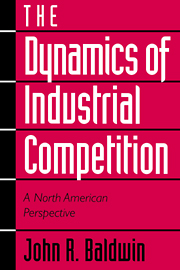Book contents
- Frontmatter
- Contents
- preface
- Acknowledgements
- 1 The dynamics of competition
- 2 Greenfield entry and closedown exit
- 3 Entry, exit, and the merger process
- 4 The rise and fall of incumbents
- 5 Patterns of large- and small-firm mobility
- 6 Plant turnover in Canada and the United States
- 7 Measures of market structure and the intensity of competition
- 8 The relationship between mobility and concentration
- 9 Turnover and productivity growth
- 10 Merger success
- 11 Turnover in domestic and foreign enterprises
- 12 Industry efficiency and firm turnover in the Canadian manufacturing sector
- 13 Firm turnover and profitability
- 14 Modelling entry
- 15 Conclusion
- Appendix A Measuring firm turnover – methodology
- Appendix B Definition of concentration and mobility measures
- Notes
- References
- Author index
- Subject index
8 - The relationship between mobility and concentration
Published online by Cambridge University Press: 30 March 2010
- Frontmatter
- Contents
- preface
- Acknowledgements
- 1 The dynamics of competition
- 2 Greenfield entry and closedown exit
- 3 Entry, exit, and the merger process
- 4 The rise and fall of incumbents
- 5 Patterns of large- and small-firm mobility
- 6 Plant turnover in Canada and the United States
- 7 Measures of market structure and the intensity of competition
- 8 The relationship between mobility and concentration
- 9 Turnover and productivity growth
- 10 Merger success
- 11 Turnover in domestic and foreign enterprises
- 12 Industry efficiency and firm turnover in the Canadian manufacturing sector
- 13 Firm turnover and profitability
- 14 Modelling entry
- 15 Conclusion
- Appendix A Measuring firm turnover – methodology
- Appendix B Definition of concentration and mobility measures
- Notes
- References
- Author index
- Subject index
Summary
Introduction
Two different but complementary approaches have been taken to the study of market processes. On the one hand, competition is described as a process by which entrepreneurs vie freely for success. Firms experiment with strategies to produce new and better goods. They take risks as they commit resources to the process. Gambles are taken when advertising campaigns are mounted to persuade the consumer to sample new product lines. Successful firms wrestle market share away from unsuccessful firms. This approach, occasionally but not exclusively associated with the Austrian school, emphasizes that it is the intensity of this contest that must be the basis of evaluating the process.
An alternative view is that competition can be approached as a state of affairs. According to this view, the dimensions of the competitive system, as complex as they might be, can be meaningfully reduced by means of a suitable classification system. This tradition emphasizes the use of statistics that summarize a state of affairs rather than a process. It uses measures of market structure derived from the firm-size distribution as proxies for the intensity of competition. The firm-size distribution is a measure that depicts the state in which an industry finds itself, rather than the process that has brought it to that position.
At the conceptual level, the two sides may not disagree as to what constitutes highly competitive markets. It is at the practical level of measurement that they differ. Those who use measures of market structure are, faute de mieux, focusing on a state of affairs. In using these measures, they are making certain strong assumptions about the ability of such measures to represent the intensity of competition within the industry.
- Type
- Chapter
- Information
- The Dynamics of Industrial CompetitionA North American Perspective, pp. 176 - 207Publisher: Cambridge University PressPrint publication year: 1995



